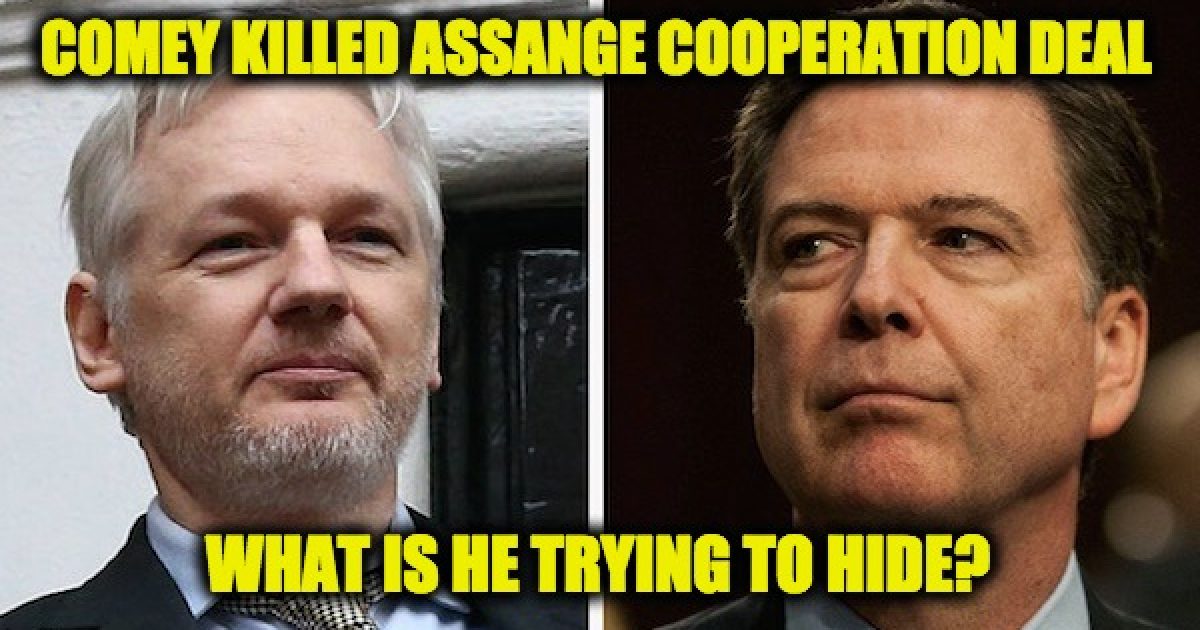Reporting from John Solomon at The Hill on Monday sheds light on a little-remarked episode in the Russiagate saga from February and March 2017. It may hold the key to a lot. Solomon’s sources say that during negotiations with WikiLeaks’ Julian Assange, from which the Justice Department hoped to get an immunity agreement and some cooperation with Assange on redacting information from upcoming WikiLeaks data dumps, FBI Director James Comey spiked the whole process. Because of Comey, negotiations were shut down.
And, of particular interest to the Russiagate narrative, Assange was also offering to explain why the source of the John Podesta email data released by WikiLeaks in 2016 could not be the Russian hackers suspected by the FBI. (Assange was not offering to disclose his source; only to discuss why his information indicated it could not be the Russians.)
After Comey shut the negotiations with Assange down, attempts to revive them were unsuccessful. The end result was the devastating WikiLeaks release on 7 April 2017 of a CIA-developed hacking framework with which to build custom malware. This wasn’t just information about the kind of capability the CIA had; it was code-level data.
In the interim – in early March 2017 – WikiLeaks released a trove of information revealing that the CIA had developed cyber tools that could mimic the profile of Russian hackers, and make it look as if a hack had been done by the Russians when it was actually the CIA.
Both WikiLeaks releases occurred after Comey spiked the negotiations, which occurred in February 2017. But the odd thing about his intervention is that it apparently was done by going around the Justice Department negotiators. Comey got the deal-making shut down via another route.
That route was Senator Mark Warner (D-VA). Long-time Warner associate Adam Waldman, a lobbyist to whom Assange had reached out in January, as the Trump inauguration approached, was brokering the talks and had put Assange in touch with Bruce Ohr and senior counterintelligence official David Laufman at the DOJ. Their series of contacts had the negotiations in full swing by mid-February 2017.
That’s when Comey weighed in, by going through Warner rather than the DOJ principals. According to John Solomon, prosecutor David Laufman was determined to go ahead with the deal for Assange. But Assange pulled back, spooked by the Comey intervention and the mixed signals. Although the back-and-forth continued into March, Assange never had the confidence he needed to commit to the deal.
Solomon has these comments:
Waldman couldn’t believe a U.S. senator and the FBI chief were sending a different signal, so he went back to Laufman, who assured him the negotiations were still on. “What Laufman said to me after he heard I was told to ‘stand down’ by Warner and Comey was, ‘That’s bullsh**. You are not standing down and neither am I,’” Waldman recalled. …
Multiple sources tell me the FBI’s counterintelligence team was aware and engaged in the Justice Department’s strategy but could not explain what motivated Comey to send a different message around the negotiations through Warner.
The events in sequence
It may help to remember that we’ve heard before about Mark Warner and Adam Waldman trying to make contact with a Russiagate player. It was at this exact time, in fact – in February and March 2017 – and the target, in that case, was Christopher Steele.
Indeed, a report from Fox News by Ed Henry, in February 2018, contained the very text-message correspondence by Warner that reflected his contact with Comey on shutting down the Assange talks. But that wasn’t visible in the Fox report, which was focused on the pursuit of Steele. We are now finding out that one of the texts in Warner’s text history is the one relating to the Comey intervention.
According to Solomon’s timeline, Adam Waldman contacted Bruce Ohr (whom he knew from previous work with DOJ) in January to set up a DOJ contact with Assange. The first message Solomon’s documentation shows was on 12 January 2017 (a busy day for Russiagate, as readers, will remember). Waldman himself met with Assange three times in London between then and 3 February, when Waldman and Ohr connected in person in Washington.
Waldman and Laufman were linked up within 24 hours, and the negotiations through Waldman took off with Assange.
It’s worth noting something quite impressive in the next few days, although it might not seem to be directly related to the Assange timeline. On 8 February, Comey went to see Trump at the White House. His memoranda on communications with Trump are posted on the FBI records site and include a brief email series memorializing the Oval Office visit.
The subject line under which the entire series occurred was “Sen. Warner Call.” In other words, the emails about Comey’s visit to the White House that day were sent under that subject line.
The correspondents in the series were Comey and his chief of staff James Rybicki. The exchanges occurred as follows (all dates 8 February 2017):
3:55 PM/Rybicki to Comey
Please call [redacted] at 6:45 PM. His EA will answer and connect you.
4:48 PM/Comey to Rybicki
Was this set up as a result of my request? I had asked Jason.
Meeting is done. Took me to oval. Will be doing another memo. Respectfully,
4:59 PM/Rybicki to Comey
No. Request of the Senator.
5:03 PM/Comey to Rybicki
Also sat and chatted with Mike Flynn in lobby.






